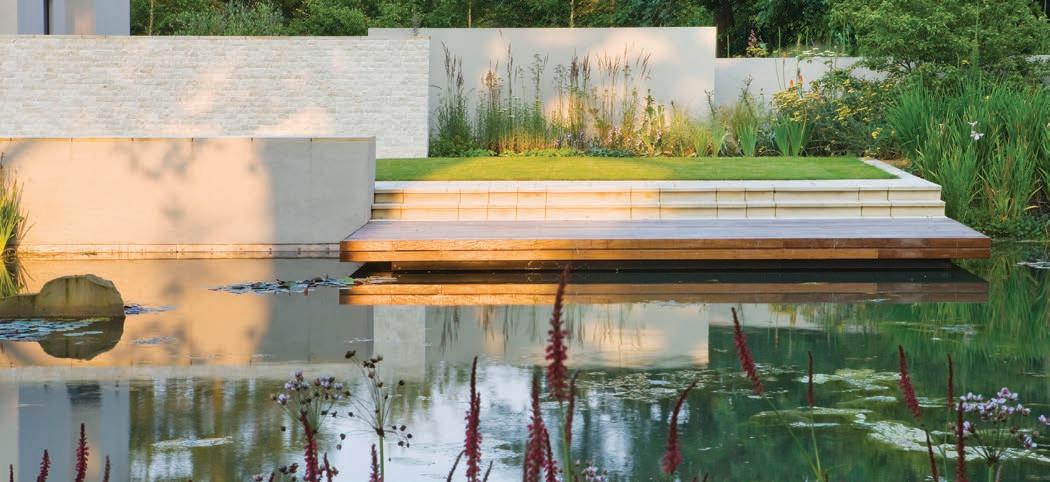
5 minute read
SUSTAINABLE OPPORTUNITIES
In light of the recent flooding across the country, landscape cost estimating specialist, Colm Kenny explores the cost implications and opportunities of retrofitting sustainable urban drainage measures
The large scale flooding in many parts of the country during the past few months has devastated the lives of the people affected and caused an estimated €1,000,000 worth of damage to property. This flooding is becoming more regular as the wet weather of recent winters, and indeed summers, has witnessed a rise in the number of flooding instances which have occurred. While it is only large scale flooding of houses and farmyards that make the national news, localised flooding of people's gardens and driveways are not worthy of national media coverage yet they occur on a weekly basis during the winter months. Government departments, local authorities and the wider construction industry as a whole have begun to realise the need to deal with surface water at source instead of dumping it into the existing drainage network which in most parts of the country is inadequate and unable to deal with the prolonged periods of wet weather.
Advertisement
The landscape industry will have an important future role to play in solving this issue. There is a general public consensus that our climate is changing with the result that surface water and its disposal will only become a bigger issue as time moves on. The development of land that typically would not have been built on due to its low
water table levels will become more common as our cities and towns expand. Wet winters will lead to more surface water while drier summers could see it going to the other extreme where a lack of water could become a problem for landscape schemes.
Both the landscape design and construction industries must become important players in attempting to solve this problem by becoming specialists in the design and installation of Sustainable Urban Drainage Systems (SUDS). This approach to managing surface water is increasingly important in drainage planning. Green roofs, permeable paving, swales, dry vegetated basins and bio-retention cells are becoming more common even on the smallest projects. Such systems are still in their infancy and products are still being developed to deal with the problems that cannot be solved with traditional drainage methods. While traditionally drainage design would have fallen within the scope of the civil engineer I have witnessed on a number of recent projects a willingness from engineers to allow landscape designers have greater input into the design and specification of SUDS techniques. This cooperation is required from all parties if the problems we currently face are to be overcome.
Swales, wetlands and ponds have become more common features of residential landscape schemes in recent years. Whether this is due to a requirement by engineers or a desire by landscape architects I am not too sure but I am happy to see them becoming part of the SUDS management plan. As well as being functional, they add character and interest to the landscape. Again it is an area that the landscape industry needs to become proficient in and not rely on their engineering counterparts to become the champions of such features.
Sustainable drainage systems are almost mandatory on new housing developments. While such systems are welcome, SUDS in new developments alone will not make a significant impact to reducing flood risk and improving water quality. New developments only account for a small percentage of housing stock per year. Hence, there is a need for a combined strategy for installing SUDS in new developments and retrofitting them to existing ones.
The perceived high cost of retrofitting is one which needs to be tackled by the industry as a whole. Homeowners and property managers need to be educated as to the benefits of retrofitting and the relatively low cost of replacing impermeable paving with sustainable permeable paving. As all the excavation and groundworks has been already carried out, the cost of retrofitting would be in the region of €40 -€50 m². The removed paving can often be recycled to become stone fill for soakaways. If the average urban
driveway is somewhere in the region of 30 m², the average cost of replacing the paving would equate to €1,500 to change. For such a small investment the homeowners would have a sustainable driveway and know they are helping to alleviate the local drainage problems.
New types of permeable surfaces are also becoming more common in both new developments and also on projects where surfaces are being upgraded. Porous asphalt, concrete and resin type surfaces have become a cost effective alternative to paving. Such surfaces are more suited to commercial landscapes where load-bearing considerations confine the type of surfaces specified by designers. While such products limit the bespoke design achievable with paving, they can compensate for this by the volumes of water they can prevent going into the traditional drainage system.
Large grass areas are not particularly effective at absorbing and retaining water, especially during heavy rains. Shrub planting tends to develop more extensive root systems that take in and hold water much better than grass areas. As an added bonus, they require less maintenance than a grass does. Similarity trees' immense root systems effectively absorb water over a large area. In addition, the canopy of a tree slows the fall of rainwater so that the ground is capable of absorbing larger amounts than it otherwise would be. Creating pockets of planting and tree planting pits within large paved areas is something that is relatively easy and cost effective to implement and construct.
The home renovation scheme which was launched a number of years ago provided a welcome boost to the landscape industry. It was a success because all the big players came together to promote it. If such a similar scheme was to be introduced offering incentives to property owners to “disconnect” roof or driveway runoff from the public drainage system and was promoted by all sectors of the industry, it would both reduce the problems caused by surface water and also provide a second boost to the industry. By offering such an incentive it would also raise awareness with homeowners as to the impact we all have on existing drainage systems. ✽
COLM KENNY, B Ag. Sc. (Land. Hort), M.Sc. Quantity Surveying. Colm is a landscape estimating specialist. He provides cost and implementation advice to landscape industry professionals, technical advisors, contractors and facility management companies. He can be contacted on 086 874 4300 or by email info@landscapeqs.ie









